Are your female chickens not using the nesting boxes? It is often common for newer hens who have started to lay eggs recently or will lay eggs soon. Encouraging them to use the nesting boxes is necessary to collect eggs on time without searching for hours.
How to get chickens to use nesting boxes? Add enough nesting boxes, keep them clean, and use the right nesting materials. Use fake eggs, maintain a dark condition by using curtains, and keep the nesting boxes low to let hens move in and out comfortably. Collect the eggs regularly and discourage chickens from laying eggs elsewhere.
How To Get Chicken To Use Nesting Boxes?
Some chickens will naturally use the nesting boxes, and some won’t. You may need to try different ways to motivate them to use the bird boxes.
But there is no hard and fast rule to train chickens to lay eggs in the nest box. Different approaches will include different chickens.
Here, we will discuss all possible ways that you can use to encourage hens to sit on the nesting boxes and lay eggs.

01. Add Enough Nesting Boxes
How many nesting boxes have you added inside or outside the chicken coop?
A regular nesting box is enough to accommodate 2 to 4 chickens based on their size and nature.
You want to avoid overcrowding issues. Otherwise, female chickens will lay eggs elsewhere as they see a too-long serial for each nesting box.
Hens mostly lay eggs during the spring, fall, and winter.
You may need to add extra boxes to give personal space to a group of chickens separately.
But you also don’t want to include too many boxes. Flocks may start misusing them as some remain empty.
02. Set Up The Nesting Boxes In A Dark Condition
Where have you placed the nesting boxes? Are the boxes exposed to too much light and in a noisy area?
Alter their location and keep them in a dark and less noisy area. Many hens prefer a dark and quiet environment for laying hens.
They will feel more secure and safe. This may encourage them to lay eggs peacefully.
Too much light makes the chickens think they are likely to get attacked by predators or others.
03. Introduce Nesting Boxes On Time At The Right Place
Did some of your chickens already start laying eggs?
Generally, female chickens start laying eggs when they are 18- 22 weeks old. Add nesting boxes must be added after birds become 16-17 weeks old.
Otherwise, they will start laying eggs on the floor. This practice will affect the younger hens.
They will be motivated to lay eggs on the floor or outside the coop.
Setting nesting boxes on time will help them to learn from their elders where to do the job.
Sometimes, roosters will train them how to lay eggs in nesting boxes by mimicking the actions of a hen.
But it will be only possible if you introduce nesting boxes on time at the right place.
04. Make The Nesting Boxes Appealing
Add clean, soft, and comfortable nesting materials to attract chickens easily.
Avoid using shaving or similar materials. They deplete over time. Flocks don’t prefer them.
Use nice soft nesting material such as straw, pine shaving, or similar items to make the nesting boxes appealing.
Try other nesting materials if your hens don’t like a particular option. And see which one they give more preference.
You can add strawberry-scented shavings, as many chickens like this smell.
Herbs like lavender, chamomile, or lemon balm are great options to create a fresh smell inside bird boxes.
Make sure to change the nesting materials regularly. Flocks are unlikely to sit and lay eggs in a dirty nesting box.
05. Keep The Nesting Box Height Comfortable
Chickens don’t land in nesting boxes in a flying position. They walk in into the nesting box normally.
What is the height of your nesting box where your birds move in and out? It should not be more than 18 to 20 inches.
Otherwise, chickens will struggle to enter and come out effortlessly.
You can add a small ramp to make them more comfortable. They might be more attracted to the nesting box.
But don’t keep the height too low. Otherwise, they will use the nesting boxes more frequently.
Plus, it will give easy access to predators and other animals.
06. Add Sufficient Light Near To The Nesting Box
Dark conditions are good for chickens, providing them enough privacy and lay eggs.
But it doesn’t mean they will be kept fully in the dark.
Flocks need to get 14-16 hours of daylight every day. Proper lighting contributes to better egg production.
Your hens may struggle to move in and out of the nesting box is completely dark.
There should be a minimum light to let birds enter the nesting box comfortably.
07. Trick Your Chickens Using Fake Eggs
Do you know hens are likely to lay eggs where they see eggs? They think it is the perfect spot for laying eggs.
Add a few fake eggs inside the nesting boxes. This will encourage them to lay their eggs.
But what fake eggs should you use? You can use golf balls, wooden, plastic, or ceramic eggs.
Besides, it will discourage the chickens from pecking and eating real eggs.
Make sure to choose heavier fake eggs to prevent chickens from moving them out of the nesting boxes.
The color and shape should look almost real too. It will help you trick chickens effortlessly.
08. Confined The Hens Till The Egg Laying Time
Do your chickens lay eggs outside the coop? Don’t release them in the early morning.
Keep hens locked until the egg-laying time. It is better to keep them confined till mid-morning for a few days.
They will try to figure out an open, less crowded space for laying eggs. Hence, chickens are more probably to use the nesting boxes.
Avoid locking them all day long. This may affect their health as they need natural daylight daily.
Once they develop the habit, you no longer need to confine them. Generally, it takes around one to two weeks.
09. Add Nesting Box Curtains
Hens prefer a little privacy when it comes to laying eggs.
Creating a dark and private condition will help flocks lay eggs more comfortably.
When your nesting boxes are set up near the windows or doors, a good amount of sunlight will likely enter the bird boxes.
If you always keep the coop light on, the nesting boxes might be too bright.
You can use one curtain for each compartment of the nesting box to create a secluded spot for your chickens.
In addition, certain will help them brood and hatch eggs by providing a hidden spot.
It will make the nesting boxes more functional and discourage vent pecking and broodiness.
10. Discourage Chickens To Lay Eggs Elsewhere
Have you figured out where your hens are laying eggs?
If it is another hidden nesting box, destroy it and make it a super flat, clean location.
If they lay eggs outside the location in a particular spot, you can add fragrant herbs and spices like garlic, paprika, chilies, cinnamon, etc.
But unless you make the nesting boxes appealing enough, they may find another spot for laying eggs.
11. Collect Eggs Regularly
Do your chickens suddenly stop laying eggs on the nesting boxes? Don’t you regularly collect eggs?
If the bird boxes are full of eggs, chickens will struggle to find a sweet spot for laying eggs.
Plus, they may break or eat the eggs once they figure out their taste.
Hens may have found another spot for laying eggs. If you are too late, they will use the nesting box even after clearing out the eggs.
It is better to collect eggs daily if you have a good number of hens.
12. Provide Enough Spaces For Roosting
Providing enough roosting is crucial to avoid competition for a roosting room.
A lack of roosting space may encourage them to use the nesting boxes at night. It will become dirty quickly as chickens poop a lot while roosting.
Hens are likely to use a dirty nesting box for laying eggs. They may look for another spot for laying eggs conveniently.
Maintaining approximately ten inches of roosting space per chicken is a good rule of thumb.
But the space can be more or less depending on the chicken size.
When flocks roost in the roosting room, nesting boxes will remain clean. They are more likely to use it for laying eggs.
13. Gently Move Your Chickens During The Egg Laying Time
Do your hens lay eggs outside the chicken coop?
You may see them stay in a particular location for several minutes until they lay eggs.
In such a case, grab and gently put her in an empty nesting box.
If the nesting box has a locking system, keep it locked for a few minutes. Leave it once it lays eggs.
You can do it for several days to allow it to create a habit. Once the chicken develops the practice, it will be less likely to lay eggs elsewhere.
Summing Up
Make nesting boxes favorite to your chickens by providing them with all the essential things they prefer. Adding fresh nesting materials and regularly cleaning the bird boxes is vital.
It may take around 2 to 3 weeks to train hens to lay eggs inside the nesting boxes. But you should always keep an eye as they may occasionally lay eggs elsewhere.
Maintain consistency to take proper care of the nesting boxes. As long as the nest boxes look appealing, chickens will use them for laying eggs.
Now, do you know how to get the chicken to use a nesting box? Try one after another until you figure out the best option.







